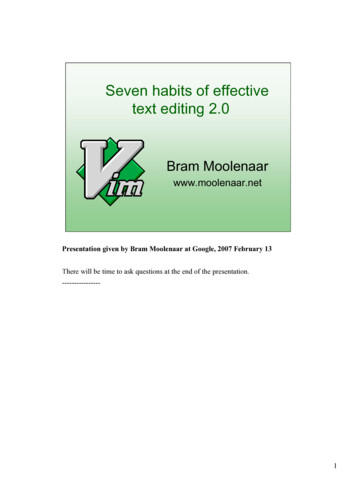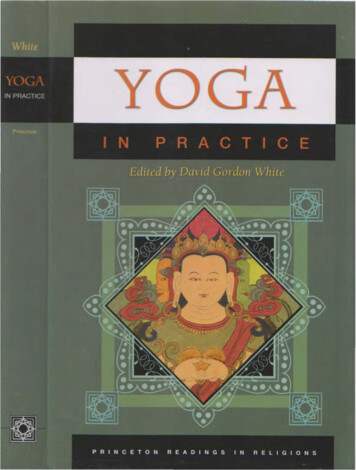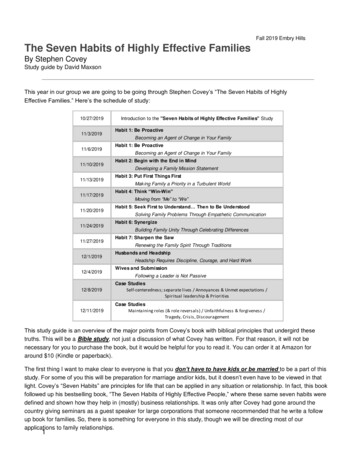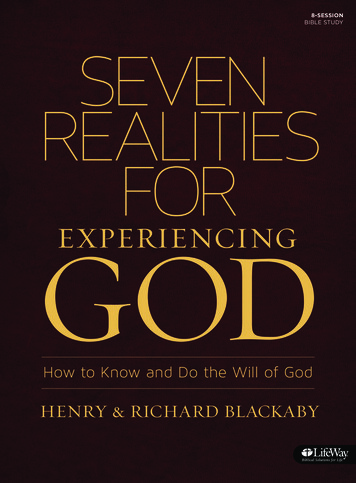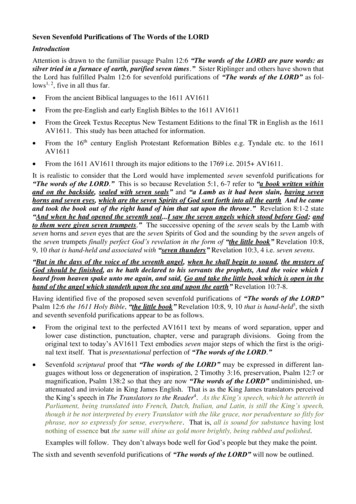
Transcription
Seven Sevenfold Purifications of The Words of the LORDIntroductionAttention is drawn to the familiar passage Psalm 12:6 “The words of the LORD are pure words: assilver tried in a furnace of earth, purified seven times.” Sister Riplinger and others have shown thatthe Lord has fulfilled Psalm 12:6 for sevenfold purifications of “The words of the LORD” as follows1, 2, five in all thus far. From the ancient Biblical languages to the 1611 AV1611 From the pre-English and early English Bibles to the 1611 AV1611 From the Greek Textus Receptus New Testament Editions to the final TR in English as the 1611AV1611. This study has been attached for information. From the 16th century English Protestant Reformation Bibles e.g. Tyndale etc. to the 1611AV1611 From the 1611 AV1611 through its major editions to the 1769 i.e. 2015 AV1611.It is realistic to consider that the Lord would have implemented seven sevenfold purifications for“The words of the LORD.” This is so because Revelation 5:1, 6-7 refer to “a book written withinand on the backside, sealed with seven seals” and “a Lamb as it had been slain, having sevenhorns and seven eyes, which are the seven Spirits of God sent forth into all the earth And he cameand took the book out of the right hand of him that sat upon the throne.” Revelation 8:1-2 state“And when he had opened the seventh seal.I saw the seven angels which stood before God; andto them were given seven trumpets.” The successive opening of the seven seals by the Lamb withseven horns and seven eyes that are the seven Spirits of God and the sounding by the seven angels ofthe seven trumpets finally perfect God’s revelation in the form of “the little book” Revelation 10:8,9, 10 that is hand-held and associated with “seven thunders” Revelation 10:3, 4 i.e. seven sevens.“But in the days of the voice of the seventh angel, when he shall begin to sound, the mystery ofGod should be finished, as he hath declared to his servants the prophets, And the voice which Iheard from heaven spake unto me again, and said, Go and take the little book which is open in thehand of the angel which standeth upon the sea and upon the earth” Revelation 10:7-8.Having identified five of the proposed seven sevenfold purifications of “The words of the LORD”Psalm 12:6 the 1611 Holy Bible, “the little book” Revelation 10:8, 9, 10 that is hand-held3, the sixthand seventh sevenfold purifications appear to be as follows. From the original text to the perfected AV1611 text by means of word separation, upper andlower case distinction, punctuation, chapter, verse and paragraph divisions. Going from theoriginal text to today’s AV1611 Text embodies seven major steps of which the first is the original text itself. That is presentational perfection of “The words of the LORD.” Sevenfold scriptural proof that “The words of the LORD” may be expressed in different languages without loss or degeneration of inspiration, 2 Timothy 3:16, preservation, Psalm 12:7 ormagnification, Psalm 138:2 so that they are now “The words of the LORD” undiminished, unattenuated and inviolate in King James English. That is as the King James translators perceivedthe King’s speech in The Translators to the Reader4. As the King’s speech, which he uttereth inParliament, being translated into French, Dutch, Italian, and Latin, is still the King’s speech,though it be not interpreted by every Translator with the like grace, nor peradventure so fitly forphrase, nor so expressly for sense, everywhere. That is, all is sound for substance having lostnothing of essence but the same will shine as gold more brightly, being rubbed and polished.Examples will follow. They don’t always bode well for God’s people but they make the point.The sixth and seventh sevenfold purifications of “The words of the LORD” will now be outlined.
2Presentational Perfection of “The words of the LORD,” the Sixth Sevenfold PurificationFrom “originally given” to Finally Perfected - Extract5God refined His word from originally given to finally perfected as the 1611 Holy Bible historically,practically, inspirationally and textually. The historical refinement follows:90 A.D. The most probable ‘original’6See Figure 1 New Testament Manuscripts 50-1500 A.D.The following citation has been adapted from Scrivener’s 1881 Edition of the Received Text, TextusReceptus, published posthumously in 1894 and reprinted by the Trinitarian Bible Society. Scrivener’s Edition is overall the closest Greek New Testament equivalent to the 1611 Holy Bible NewTestament drawn mainly from Beza’s 1588-1589 and 1598 Greek Received Text Editions that theKing James translators used extensively. Note, however, as Gail Riplinger shows, Hazardous Materials, Chapter 18, The Trinitarian Bible Society’s Little Leaven, TBS Scrivener-Beza Textus Receptus, Scrivener’s text is not finally authoritative for the Greek New Testament and cannot be used inauthority over the 1611 Holy Bible English New Testament.See the attached study Seven Purifications of the Textus Receptus, Received Text.The most probable original example passage for a 1st century Greek script immediately �ΑΛΛΕΧΗΖΩΗΝΑΙΩΝΙΟΝA considerably improved form of the passage now follows. Note that in addition to translation into“words easy to be understood” 1 Corinthians 14:9, vast strides have been made with respect to thepresentation of the passage that will be addressed in more detail below.1611 A.D.John 3:16 For God so loued ye world, that he gaue his only begotten Sonne: that whosoeuer beleeueth in him, should not perish, but haue euerlasting life.The finally perfected form of the passage now follows. The 1611 Gothic type style and Gothic letterforms e.g. u for v and vice versa, y for th, have been updated to Times New Roman and 1611spelling has been standardised to contemporary spelling8.1769 A.D.9 to 2015 A.D. John 3:16 For God so loved the world, that he gave his only begotten Son, that whosoever believethin him should not perish, but have everlasting life.Concerning the progression of the written scriptures from 90 A.D. to 1611, when the then 1611 HolyBible contained all the presentational features of today’s 2015 1611 Holy Bible, note these extractsfrom Punctuation and Bible Chapter and Verse Division sources under the above reference. Noteespecially that the scripture was the driving force for the development of punctuation.Punctuation – MedievalPunctuation developed dramatically when large numbers of copies of the Bible started to be produced. These were designed to be read aloud, so the copyists began to introduce a range of marks toaid the reader, including indentation, various punctuation marks (diple, paragraphos, simplex ductus),and an early version of initial capitals (litterae notabiliores).In the 7th-8th centuries Irish and Anglo-Saxon scribes, whose native languages were not derivedfrom Latin, added more visual cues to render texts more intelligible. Irish scribes introduced thepractice of word separation.
3Later developmentsFrom the invention of moveable type in Europe in the 1450s the amount of printed material and areadership for it began to increase. “The rise of printing in the 14th and 15th centuries meant that astandard system of punctuation was urgently required” [Truss, Lynn (2004). Eats, Shoots & Leaves:The Zero Tolerance Approach to Punctuation. New York: Gotham Books. p. 77]. The introductionof a standard system of punctuation has also been attributed to the Venetian printers Aldus Manutiusand his grandson [circa 1566]. They have been credited with popularizing the practice of endingsentences with the colon or full stop, inventing the semicolon, making occasional use of parenthesesand creating the modern comma.Question: “Who divided the Bible into chapters and verses? Why and when was it done?”Answer: When the books of the Bible were originally written, they did not contain chapter or versereferences. The Bible was divided into chapters and verses to help us find Scriptures more quicklyand easily. It is much easier to find “John chapter 3, verse 16” than it is to find “for God so loved theworld.” In a few places, chapter breaks are poorly placed and as a result divide content that shouldflow together*. Overall, though, the chapter and verse divisions are very helpful.*No changes have ever been made, though. See the attached study Archbishop Stephen Langton –Charter Framer and Chapter Divider.The chapter divisions commonly used today were developed by Stephen Langton, an Archbishop ofCanterbury. Langton put the modern chapter divisions into place in around A.D. 1227. The Wycliffe English Bible of 1382 was the first Bible to use this chapter pattern. Since the Wycliffe Bible,nearly all Bible translations have followed Langton’s chapter divisions.The Hebrew Old Testament was divided into verses by a Jewish rabbi by the name of Nathan in A.D.1448. Robert Estienne, who was also known as Stephanus, was the first to divide the New Testament into standard numbered verses, in 1555. Stephanus essentially used Nathan’s verse divisionsfor the Old Testament. Since that time, beginning with the Geneva Bible, the chapter and verse divisions employed by Stephanus have been accepted into nearly all the Bible versions.As indicated, God refined His word from originally given to finally perfected as the 1611 Holy Bible historically, practically, inspirationally and textually. The practical refinement follows.See the following extracts from this writer’s earlier work10 for a summary list of how that refinementwas carried out practically beginning with a shrewd evaluation of the ‘originals-onlyism’ mindset.This gentleman [our critic] is now deceased. However, a sister in the LORD in the USA had this tosay in a note to this author about our critic after reading the hard copy edition of “O Biblios.”The sister’s note makes for sombre reading.“This man’s criticisms are unbelievable. Really, complaining about the use of Saint for the fourgospels. I don’t really believe this man is saved much less has taken time to read the bible. I’mthinking that he only went to school to learn from the ‘scholarly’ men who taught him to disbelievethe bible. I think [our critic] was not a believer at all, Alan. It doesn’t seem possible with some ofthe things he said. To get so upset and write a 20 page thesis on what’s wrong with God’s word justto put you in your place so to speak. That doesn’t appear to be the least bit Godly.”“Be not deceived; God is not mocked: for whatsoever a man soweth, that shall he also reap”Galatians 6:7.
48.2.7. “Your claims that the KJV is superior to the original Hebrew and Greek.the God breathedoriginals are unacceptable”1.7 specific verses substantiating these “claims” have been cited [Numbers 33:52, Psalm 74:8,Daniel 11:38, Acts 12:4, 19:37, 2 Corinthians 2:17, Galatians 2:20]. See Chapter 5. A total of60 examples can be obtained from Ruckman [Biblical Scholarship Dr Peter S. Ruckman], Appendix 7 plus issues March, April 1989 and November 1991 of the Bible Believers’ Bulletin.2.I repeat several reasons why the AV1611 is superior to “the originals” [The Bible Babel Dr Peter S. Ruckman] p 118.The AV1611:2.1 can be READ, the originals CANNOT and were NEVER collated into one volume. Theverse usually quoted in support of “the God-breathed originals,” 2 Timothy 3:16, refers tocopies of the scriptures, NOT the original.2.2 has chapter and verse divisions, which even the modern translations must follow. The oldest manuscripts do NOT.2.3 has word separation so that it can be more easily understood. The oldest manuscripts doNOT.2.4 is arranged in Pre-millennial order which the Masoretic text is NOT and even though thetranslators were NOT Pre-millennial. Again, the modern translations must follow this order.2.5 is rhythmical and easy to memorise which Greek and Hebrew are NOT.2.6 has been responsible for the conversion of more souls than any original autograph or anycopy made within 5 centuries of the original autographs.2.7 is in the universal language which Greek and Hebrew are NOT. Hebrew is spoken by approximately 1% of the world’s population. New Testament Greek is a DEAD language, noteven spoken in Greece, which incidentally is one of the most spiritually impoverished nations in Europe, according to the Trinitarian Bible Society.Note especially points 2.1, 2.2, 2.3, 2.4, 2.5, 2.7 from the above list in addition to the detailed material from the web sources on how the Lord refined His word from originally given to finally perfected as the 1611 Holy Bible according to interwoven historical and practical refinements, the sixthsevenfold purification of “The words of the LORD” the 1611 Holy Bible, “the little book” Revelation 10:8, 9, 10 that is hand-held.Figure 1 New Testament Manuscripts 50-1500 A.D. depicts the nature of this sixth sevenfold purification.Following the attached studies Seven Purifications of the Textus Receptus, the Received Text andArchbishop Stephen Langton – Charter Framer and Chapter Divider the seventh and final sevenfold purification of “The words of the LORD” will be addressed with respect to scriptural proofthat “The words of the LORD” Psalm 12:6 may be expressed in different languages without loss ordegeneration of inspiration, 2 Timothy 3:16, preservation, Psalm 12:7 or magnification, Psalm 138:2so that they are now “The words of the LORD” undiminished, un-attenuated and inviolate in KingJames English.
5Figure 1 New Testament Manuscripts 50-1500 A.D.
6Seven Purifications of the Textus Receptus, the Received TextIntroductionHistorical Bibles, English Bibles and the 1611 Holy Bible Editions have all been shown to have undergone a seven stage purification process according to Psalm 12:6-7.“The words of the LORD are pure words: as silver tried in a furnace of earth, purified seventimes. Thou shalt keep them, O LORD, thou shalt preserve them from this generation for ever.”See www.timefortruth.co.uk/why-av-only/ The purification of the Lord’s word – Psalm 12:6-7 andalso divietro-and-dawaite.php Seven Stage Purification Process – Oil Refinery – in answer to the AV1611 critics.The Textus Receptus or Received Text has also undergone seven purification stages according toPsalm 12:6-7, the final perfected stage being the 1611 Holy Bible, in English, not Greek.This work explains these seven purification stages for the Textus Receptus or Received Text.History of the Textus ReceptusThis site is useful for information on the publication dates of the Textus Receptus and the editors.See www.prca.org/pamphlets/pamphlet 9.html#sources. The writer says this:PrefaceThe Bible is no ordinary book. It is not a human book. The Bible is God’s inspired and infallibleWord - God’s Book. It is the Book which God has given to His people to teach them the Truth whichthey must believe and the godly life which they must live. That is why the Bible is so important forevery believer. Without the Holy Scriptures the believer has no Word of God. He has no standard ofwhat is the Truth and what is the lie, what is righteous and what is wicked.Does this mean that the 1611 Holy Bible is “all scripture” that “is given by inspiration of God” 2Timothy 3:16 according to that author? No. Nowhere does the author actually identify any inspiredBible. However, he provides this information.The Greek text was readily available in the Complutensian Polyglot (1514), the five editions ofErasmus (1516-1535), the four editions of Robert Stephanus (1546-1551), and the ten editions ofTheodore Beza (1560-1598). They also consulted the editions of Aldus (1518), Colinaeus (1534),and Plantin (1572).Christopher Plantin published the Antwerp Polyglot en.wikipedia.org/wiki/Plantin Polyglot.Peter Heisey, USA missionary to Romania, confirms that the King James translators specificallyconsulted the edition of Aldus as one of their sources for the Textus Receptus. See Waiting for Dr-Waite-Letter-Size.Another useful site is this www.monergism.com/thethreshold/sdg/vincent textualcriticism.htmlthough the author Dr Marvin Vincent of Union Theological Seminary 1899 was not a Bible believer*and rejected the Received Text, as the site shows. That is beside the point, though, because Vincent’s work includes a detailed history of the editions of the Textus Receptus.*As an aside, the sheep-fleecers are still out there as Matthew 7:15 shows. “Beware of false prophets, which come to you in sheep’s clothing, but inwardly they are ravening wolves.” This Bible.html appears supportive of the 1611 HolyBible, especially with its graphics - see figure - until the writer refers with approval to the stance ofDr Donald Waite of the Dean Burgon Society www.deanburgonsociety.org/ on the 1611 Holy Bible.Unsurprisingly the writer then disparages the names which are below every name for this crowd whoprofess to believe the 1611 Holy Bible but don’t believe it; Ruckman and Riplinger, who profess tobelieve the 1611 Holy Bible and do believe it. The writer, who is obviously a Waite-ite, of coursehas no Bible that is all scripture given by inspiration of God. The ministry’s Constitution
7www.bereaninternetministry.org/Church.html states that We believe that the Bible is the inerrant,infallible, verbally inspired, equally inspired, eternal Word of God This assembly will not allowany Bible to be used in the pulpit or teaching ministry other than the authorized King James Version.However, nowhere does the Constitution state that the 1611 Holy Bible is “all scripture” that “isgiven by inspiration of God” 2 Timothy 3:16. Hal Lindsey in Satan is Alive and Well on PlanetEarth p 80 says that the Devil will use a lake of truth to disguise a pint of poison. See Postscript –How the Poison is Spread. The Waite-ites are similar and more dangerous than Bible rejecters likeMarvin Vincent. Vincent overtly rejected the Received Text and in turn rejected the 1611 Holy Bible but the Waite-ites are more deadly. They covertly sap faith in the 1611 Holy Bible as “the purewords of the LORD” Psalm 12:6 because they do what “what the ancients of the house of Israeldo in the dark, every man in the chambers of his imagery” Ezekiel 8:12 in that they insist that theyhave the pure Bible in Hebrew/Aramaic/Greek but as Nehemiah rebuked the enemies of Israel“There are no such things done as thou sayest, but thou feignest them out of thine own heart”Nehemiah 6:8. See divietro-and-dawaite.phpD. A. Waite Response and Reply to DiVietro’s attack on Gail Riplinger - Flotsam Flush.Getting back to Vincent’s work, he states this about Aldus’ Edition and the Complutensian Polyglot.Although the emperor had protected Erasmus’s first edition against reprint for four years, it was reproduced by Aldus Manutius, with some variations, but with most of the typographical errors, atVenice, in 1518. It was placed at the end of the Græca Biblia, the Aldine Septuagint.The printing of the entire work was completed on the 10th of July, 1517. But though the first printed,this was not the first published edition of the Greek Testament. Pope Leo X withheld his approvaluntil 1520, and the work was not issued until 1522, three years after the cardinal’s [Ximenes] death,and six years after the publication of Erasmus’s Testament. The entire cost was about 115,000, andonly six hundred copies were printed.This work is known as the Complutensian Polyglot.Vincent of course lists the Elzevir Editions beginning in 1624 and including the 1633 Edition fromwhich the term Textus Receptus is obtained.The 1611 Holy Bible, the Perfect Textus ReceptusDr Hills makes this insightful comment. . Seestandardbearers.net/uploads/The King James Version Defended Dr Edward F Hills.pdf Chapter8 and printed edition p 220.the King James Version ought to be regarded not merely as a translation of the Textus Receptusbut also as an independent variety of the Textus ReceptusThis writer believes that the 1611 Holy Bible is both an independent variety of the Textus Receptusand the authoritative, perfect final version of the Textus Receptus on the basis of the sevenfold purification process that Psalm 12:6-7 set out and is observed in the history of the Textus Receptus.The Seven Stage Purification of the Textus ReceptusThe pre-1611 editions of the Received Text may reasonably be listed as follows, combining the individual editions of each editor. The Elzevir editions are set aside because they are post-1611.1.2.3.4.5.6.7.Erasmus/Aldus 1516-1535, 1518 – Aldus being mainly a reproduction of Erasmus’ 1st EditionXimenes/Stuncia/Complutensian 1522Colinaeus 1534Stephanus 1546-1551Beza 1560-1598Plantin/Antwerp1611 Authorized King James Holy Bible
8Conclusions may be drawn from the above list that in certain respects would horrify the Waite-ites,as least by profession. Like Saul with Stephen they, like all critics of the 1611 Holy Bible, knowthey’re wrong by means of the witness of “the true Light, which lighteth every man that comethinto the world” John 1:9 but they don’t want to be put out of the synagogue, aka self-styled (Nehemiah 6:8) OOOOO – Origenistic Order of Obstinate Originals-Onlyists John 3:19, 9:22, Acts 7:58,8:1-3, 22:19-20. They therefore will not submit to 2 Corinthians 4:1-2. “Therefore seeing we havethis ministry, as we have received mercy, we faint not; But have renounced the hidden things ofdishonesty, not walking in craftiness, nor handling the word of God deceitfully; but by manifestation of the truth commending ourselves to every man’s conscience in the sight of God.”The historical languages Bibles, the English Bibles up to 1611 and the King James Bible Editions allfulfil Psalm 12:6-7 with respect to “The words of the LORD” Psalm 12:6. As shown, history showsthat the Textus Receptus likewise follows a seven stage purification process as Psalm 12:6-7 set outbut its final perfected inspired form is in English, not Greek and is the 1611 Holy Bible. Therefore:Conclusions1.Rome i.e. Ximenes etc. is relegated to a stage in the Textus Receptus purification process.Rome is not allowed “to have the preeminence among them” 3 John 9. God has supersededRome’s single contribution to the purification process.2. The pre-1611 Textus Receptus editors are not allowed “to have the preeminence among them”3 John 9. God has superseded their contributions.3. The Greek, so-called, is not allowed “to have the preeminence among them” 3 John 9. Godhas superseded the Greek, so-called, with the 1611 Holy Bible English. That would make theWaite-ites etc. howl and that is God’s way of revealing them for what they are because sheepdon’t howl. Wolves do. See remarks on Matthew 7:15 above.4. The post-1611 Textus Receptus editors are not allowed “to have the preeminence among them”3 John 9 because God determined how His Received New Testament Text would progress before the year 1624. The post-1611 editors contributed a name. It has stuck and is useful but thatis all. However, every post-1611 scholar against the inspired 1611 Holy Bible has as “hisheart’s desire” Psalm 10:3 “let us make a name” Genesis 11:4 for himself, even if he has to doit by means of the Devil’s lake of truth/pint of poison. See Postscript.5. The 1611 Holy Bible is “the word of a king” Ecclesiastes 8:4 in English. It can be turned into1st century Greek by reverse translation but the result is not the original nor is it authoritative because “God is finished with it.” See In Awe of Thy Word p 956. It would simply picture theoriginal for specialist studies, with no power at all.6. The 1611 Holy Bible in English is the language of the End Times. See In Awe of Thy Word pp19ff. Any language may have “the words of the LORD” Psalm 12:6 if “It is turned as clay tothe seal” Job 38:14 of the 1611 Holy Bible that should be the standard for all non-English translations. See purebiblepress.com/bible/ and A Brief Analysis of Missionary Authority by JonathanRichmond Bible Believer’s Bulletin August 2013 p 6. That is a further blessing from the Authorof the 1611 Holy Bible in addition to superseding the Greek so-called.7. If that is how God perceives His sevenfold purified Textus Receptus today, the sevenfold purified 1611 Holy Bible, as this writer believes that He has, then all would-be 1611 Holy Bibleclarifiers, correctors, improvers etc. by means of the Greek, so-called, should pay careful attention to the following warning from a king, no less. Cruel and unusual punishments are no morewhere the 1611 Holy Bible has held sway but an offender still fossicking “for words buried inhaunted Greek graveyards” In Awe of Thy Word p 544, can still be hung out to dry and his ministry still downgraded by the Offended Party into “the dross of silver” Ezekiel 22:18 and “therefuse of the wheat” Amos 8:6. “The word of a king” Ecclesiastes 8:4 follows.Ezra 6:11: “Also I have made a decree, that whosoever shall alter this word, let timber be pulleddown from his house, and being set up, let him be hanged thereon; and let his house be made adunghill for this.”
9Postscript – How the Poison is 20Bible.html item by Pastor Kelly SensenigFirst comes the differentiation between pure and corrupt scripture sources, presented with vivid andindeed helpful graphics. Who could doubt the presenters? “No doubt but ye are the people, andwisdom shall die with you” Job 12:2.Then comes the declaration: This assembly will not allow any Bible to be used in the pulpit or teaching ministry other than the authorized King James Version. Who could doubt the declarers?Followed by the disclaimer and the denial, emphases in original, this writer’s remarks in braces []:.we must also reject the teaching of those “KJV-only” proponents (Peter Ruckman and GailRiplinger) who claim that the English of the KJV is inspired and superior to the underlying Hebrewand Greek texts of the KJV. This is an erroneous position and error that is rejected by most loyalKing James followers, Dr. Waite, being one of them, who stated: “God Himself did not ‘breathe out’English, or German, or French, or Spanish, or Latin, or Italian. He did ‘breathe out’ Hebrew/Aramaic, and Greek” (Waite, Defending the King James Bible, p. 246). Of course, Dr. Waiteis not saying that our English King James Version lacks inspiration [he is], what he is referring to isthat.[no-one] can one claim that every word in the English of the KJV is inspired in the same way,as the autographs (without flaw and error) [Did not the Holy Ghost give the word of God at first inthe mother-tongue of the nations to whom it was addressed? Why do you speak against the HolyGhost? – John Wycliffe, John Wycliffe: The Dawn of the Reformation pp 45-46], or the descendentmanuscripts in the original Hebrew and Greek text, which also preserve the inspired text [unidentified]. The English does not correct the languages; the languages correct the English [the 1611Holy Bible lacks inspiration]. In a similar way, the Greek at times corrects the translators [the1611 Holy Bible lacks inspiration]; the translators do not correct the Greek [the 1611 Holy Biblelacks inspiration].Inspiration and preservation specifically applies to the Hebrew and Greek texts not a certain type of English language [the 1611 Holy Bible lacks inspiration]. Think of it this way;if the 1611 King James Bible with its English was the only inspired Bible, then those versions before1611 (Tyndale’s English version and all other Bible versions with a Received Text base) were notGod’s Word and the Church did not possess the truth until 1611. Those living in 1610 did not havethe Bible. This is a rather silly and unlearned position [the same must apply to the Textus ReceptusEditions in the figure. The writer ignores this].As stated previously, the Greek corrects the English, the English does not correct the Greek [which Greek edition?]. In spite of the conclusions ofthe King James Only Movement, there is no such thing as double inspiration (the translators of the1611 King James Version were inspired and the English of the King James Version is inspired) [SeeIsaiah 53:7/Acts 8:32]. However, we do believe that.we possess an inspired Bible that has been accurately copied and passed down to us through the transmission process [Bible unidentified].Thereby the deceivers (supposedly indubitable) dupe the victims who are as “children, tossed to andfro.by the sleight of men, and cunning craftiness, whereby they lie in wait to deceive” Ephesians4:14. A shock awaits the deceivers who forsook “the word of a king” Ecclesiastes 8:4. At “thejudgment seat of Christ” Romans 14:10 “their folly shall be manifest unto all men” 2 Timothy 3:9.
10Archbishop Stephen Langton – Charter Framer and Chapter DividerArchbishop Stephen Langton - “a chosen vessel unto me” Acts 9:15The Christian Institute11 has compiled a mostinformative synopsis of Magna Carta12. June15th 2015 was the 800th Anniversary of MagnaCarta. We should note that Archbishop Stephen Langton circa 1150-122813 was not onlythe prime mover in framing Magna Carta butGod used him to create the chapter divisions inthe scripture that we have today. As “a chosen vessel unto me” Acts 9:15 Bro. Langtondid a good job before two kings, as CharterFramer before an earthly king and Chapter Divider before “the King of kings and Lord ofLords” 1 Timothy 6:15 thereby meriting KingSolomon’s commendation and bar14. See below. Note that the man may be a tyrant – nolater English or British king has been named ortaken the name John for the purpose of reigning – but still not a mean man, rather one withgreat power, even if like John he misuses it.“Seest thou a man diligent in his business?he shall stand before kings; he shall not standbefore mean men” Proverbs
From the 16th century English Protestant Reformation Bibles e.g. Tyndale etc. to the 1611 AV1611 From the 1611 AV1611 through its major editions to the 1769 i.e. 2015 AV1611. It is realistic to consider that the Lord would have implemented seven




